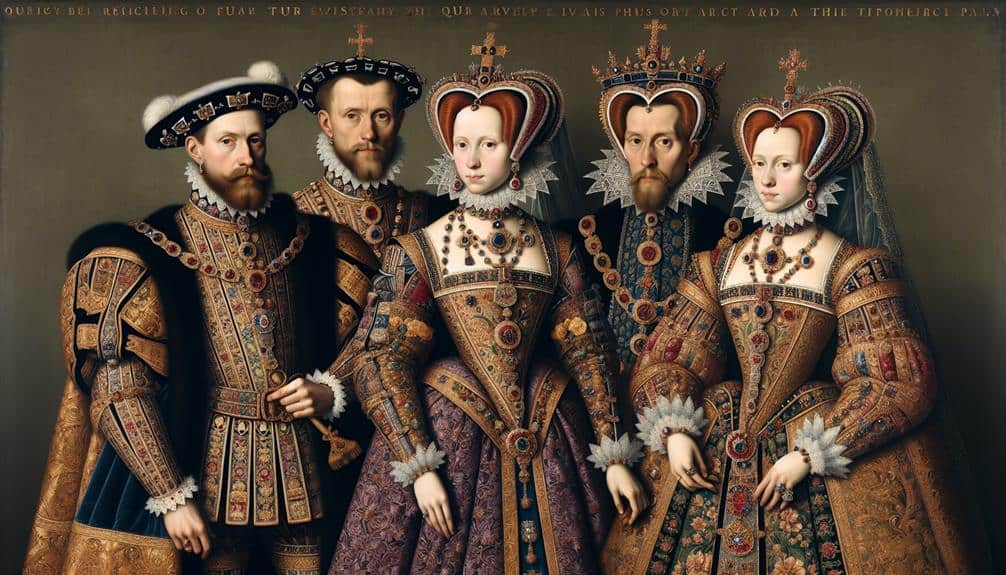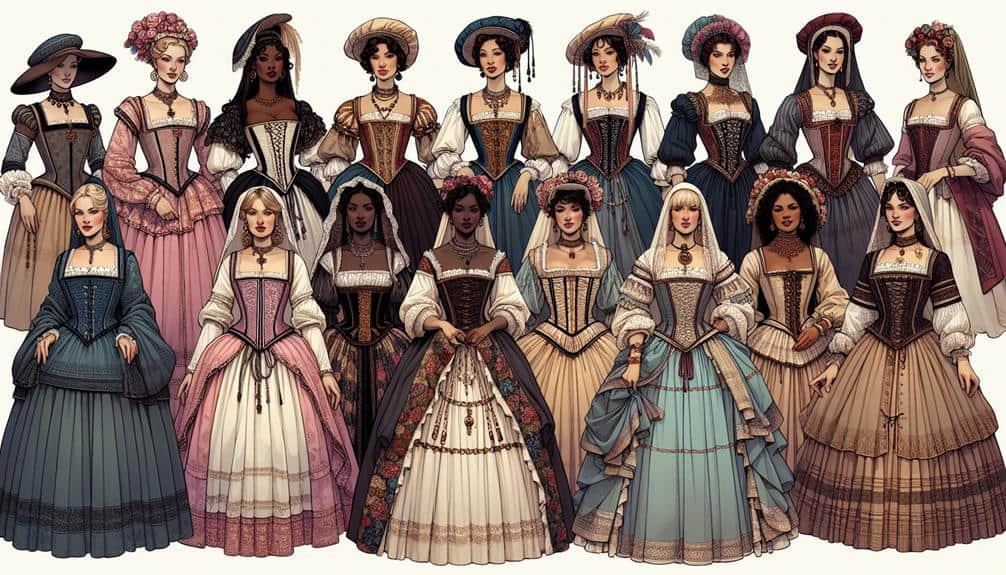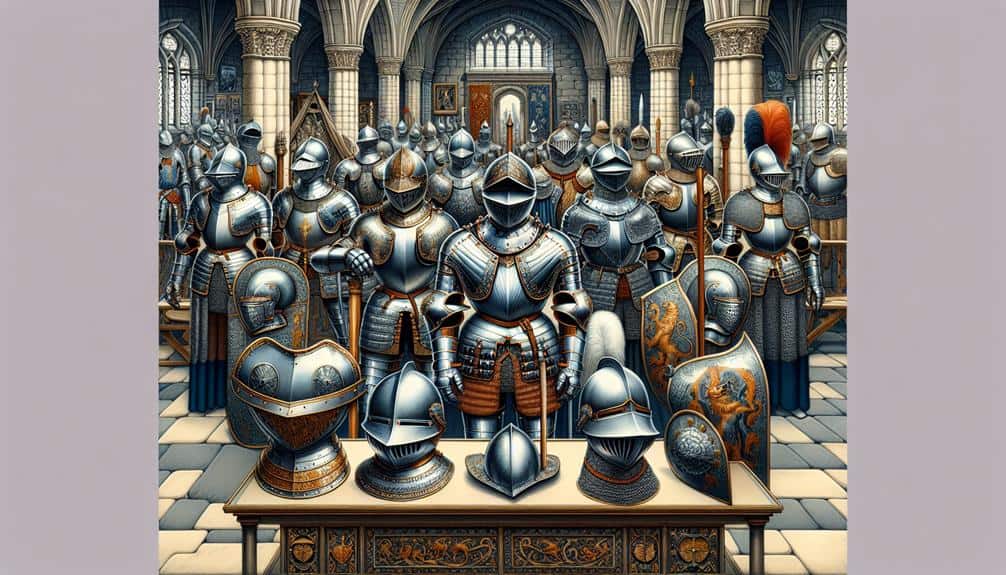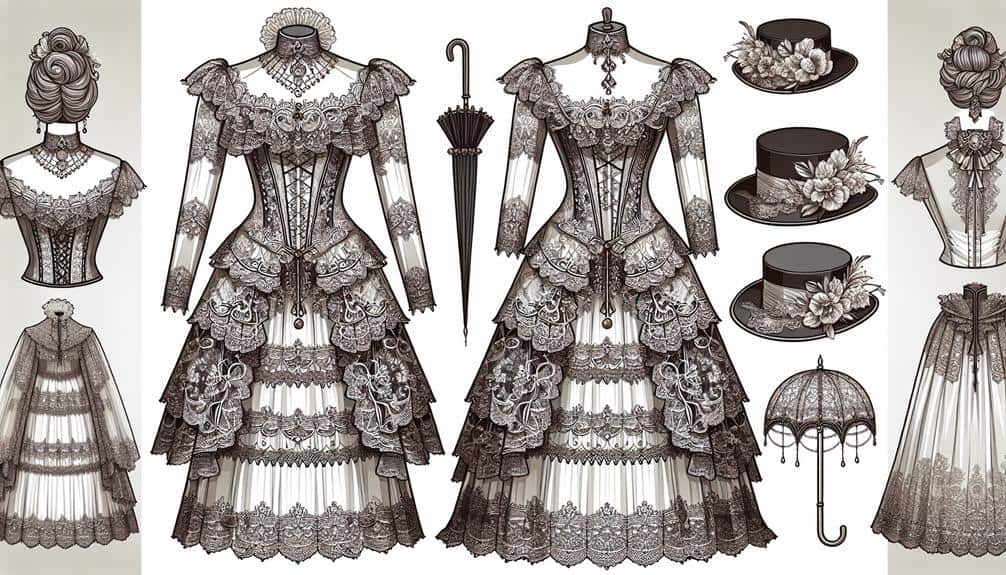Imagine stepping back into the opulent world of Tudor England, where every stitch in the royal family's attire whispered tales of grandeur and significance.
But why did the Tudor royals choose to adorn themselves in such extravagant garments, crafted with intricate details and lavish materials?
The allure of their attire extended beyond mere fashion statements, weaving a complex web of power dynamics, societal expectations, and strategic messaging that captivated both courtiers and commoners alike.
The flamboyant outfits of the Tudor royals were not just about style; they were a reflection of an intricate tapestry of historical, political, and cultural influences that shaped the very fabric of their reign.
Key Takeaways
- Tudor royal attire symbolized power, status, and dominance in society.
- Luxurious elements like rich fabrics and opulent accessories showcased wealth and importance.
- Clothing choices reflected lineage, authority, and heritage through heraldry and symbolism.
- Extravagant outfits served as a political tool, projecting grandeur and reinforcing the royal family's dominance.
Influence of Power and Status
The extravagant outfits worn by the Tudor royal family not only reflected their power and status but also served as a visual representation of their influence and authority in society. During the Tudor era, clothing played a critical role in displaying power dynamics and reinforcing the social hierarchy. The intricate garments, made from luxurious fabrics and adorned with elaborate embellishments, were meticulously designed to showcase the wealth and importance of the royals.
Within the Tudor court, clothing was a tool used to assert dominance and command respect. The sumptuous attire worn by the monarch and their family members conveyed a message of superiority to the courtiers and the public. By dressing in opulent garments, the royal family established themselves as the pinnacle of the social hierarchy, setting themselves apart from the nobility and commoners.
Furthermore, the elaborate ensembles worn by the Tudor royals weren't only symbols of their elevated status but also served as strategic instruments of influence. The carefully curated wardrobe choices of the monarch and their relatives helped shape perceptions, solidify alliances, and navigate the intricate web of court politics. Essentially, the extravagant outfits of the Tudor royal family weren't merely fashion statements but powerful tools that wielded significant influence within the dynamics of their society.
Symbolism in Royal Attire
How does symbolism play a role in the attire of the Tudor royal family?
Symbolism in Tudor royal attire went beyond mere fashion; it was a way to communicate power, lineage, and cultural significance. Here's how symbolism was intricately woven into their clothing:
- Royal Heraldry: The intricate designs and symbols on Tudor garments, such as lions and fleurs-de-lis, represented the royal family's lineage and connections to other noble houses.
- Color Symbolism: The colors worn by Tudor royals held specific meanings; for example, purple symbolized royalty and wealth, while white represented purity and innocence.
- Embroidery and Patterns: Elaborate embroidery and patterns on royal garments often depicted scenes from mythology or biblical stories, adding layers of symbolic meaning to the attire.
- Accessories: Accessories like crowns, scepters, and garters weren't just decorative but carried deep symbolic significance, denoting authority, divine right, and chivalric honor.
These symbolic elements in Tudor royal attire served not only as fashion statements but as visual markers of the royal family's power, prestige, and cultural heritage.
Luxurious Fabrics and Embellishments
Indulge in a journey through the opulent world of Tudor royal fashion, where luxurious fabrics and intricate embellishments reign supreme, defining an era of extravagant style and grandeur. The Tudor royal family spared no expense when it came to adorning themselves in the most sumptuous fabrics available. Rich velvets, brocades, and silks were favored for their luxurious textures and vibrant colors, reflecting the wealth and power of the monarchy.
Intricate craftsmanship played a pivotal role in enhancing the lavishness of Tudor attire. Skilled artisans meticulously embroidered elaborate designs with gold and silver threads, pearls, and gemstones onto the royal garments, creating a dazzling display of opulence. These embellishments not only showcased the wearer's status but also served as symbols of prestige and nobility.
Opulent accessories further elevated the grandeur of Tudor royal outfits. Ornate jewelry, such as bejeweled crowns, intricate necklaces, and jeweled belts, were meticulously crafted to complement the lavish attire. Each accessory was meticulously chosen to enhance the overall regal appearance, making a bold statement about the wearer's social standing and authority in the Tudor court.
Fashion Trends of the Tudor Era
Exploring the intricate tapestries of Tudor fashion reveals an era marked by ever-evolving trends and sartorial innovations that captured the essence of royal extravagance. During the Tudor era, fashion wasn't just about clothing but also a reflection of social hierarchy and power dynamics. Here are some key aspects that defined the fashion trends of the Tudor era:
- Sumptuary Laws: These laws regulated what colors, fabrics, and styles could be worn based on a person's social rank, reinforcing distinctions between different classes.
- Renaissance Influence: The Tudor period saw a revival of classical aesthetics, leading to the incorporation of intricate patterns, rich colors, and voluminous silhouettes in clothing.
- The Rise of Tailoring: Tailored garments became increasingly popular, emphasizing the human form and allowing for more personalized fits that showcased status and wealth.
- Fashion Evolution: From the elaborate gowns of the early Tudor period to the more structured and embellished outfits of the later years, fashion evolved reflecting the changing tastes and societal norms of the time.
Extravagance as a Political Tool
Extravagance, when strategically employed, served as a potent tool for asserting political influence and dominance during the Tudor era. In a society where social hierarchy was paramount, the royal family's extravagant outfits weren't merely a display of wealth but a calculated form of political manipulation. By wearing opulent garments adorned with rare jewels and intricate embroidery, Tudor monarchs and their family members could subtly convey messages of power, status, and authority to both the nobility and the common people.
These elaborate ensembles were meticulously designed to enhance the royal family's image and reinforce their position at the top of the social hierarchy. Through their attire, Tudor royals could assert their superiority over rival factions, intimidate potential adversaries, and garner the loyalty and admiration of their subjects. The strategic use of extravagance in clothing allowed the royal family to project an aura of grandeur and magnificence, solidifying their grip on power and ensuring their continued dominance in the tumultuous world of Tudor politics.
Frequently Asked Questions
How Did the Tudor Royal Family's Extravagant Outfits Impact the Common People During This Era?
During the Tudor era, the royal family's extravagant outfits reinforced social hierarchy, with lavish attire symbolizing power and wealth. This display of opulence had economic implications, creating a stark divide between the nobility and common people.
Were There Any Specific Rituals or Ceremonies That Required the Royal Family to Wear Particularly Lavish Attire?
During Tudor times, ritualistic ceremonies demanded the royal family to don lavish attire, symbolizing power and status. These extravagant garments not only impressed but also reinforced the hierarchical structure, emphasizing the elite's authority.
Did the Tudor Royal Family's Extravagant Outfits Influence Fashion Trends in Other European Courts?
When it comes to the Tudor royal family's extravagant outfits, their influence on fashion trends in European courts was significant. Their luxury impact on commoners' attire was profound, shaping styles and setting standards for elegance across the continent.
Were There Any Restrictions or Guidelines in Place Regarding Who Could Wear Luxurious Fabrics and Embellishments in Tudor Society?
In Tudor society, social status dictated who could flaunt luxurious fabrics and embellishments. Fashion rules were strict; commoners faced restrictions on extravagant dressing. The elite, however, paraded in opulent outfits, showcasing their wealth and power.
How Did the Cost of Maintaining Such Extravagant Wardrobes Affect the Tudor Royal Family's Finances and Overall Wealth?
Maintaining extravagant wardrobes had a significant impact on Tudor royal family finances. The costs of luxurious fabrics and embellishments strained their wealth preservation efforts. Balancing opulence with financial stability was a delicate task for the royals.



